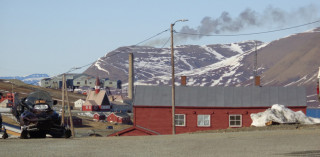Three futures for Longyearbyen

Longyearbyen, the ‘capital’ of Svalbard (or Spitsbergen as it is called by some), is a lively community that is now facing closure of its cornerstone-industry: coal mining. World market prices have plummeted, operating costs are high, and coal power is perhaps too much of a paradox for the Norwegian government priding itself on sustainable energy and environmental protection of the archipelago’s wilderness.
Talking to a number of stakeholders and locals, three ideas of the future of Longyearbyen emerged:
1. Tight footprint
From the future Governor of Svalbard (currently the General Director of Norway’s Polar Affairs Department) Kjerstin Askholt, we learned that the policies for preserving Svalbard’s untouched wilderness trumps all other considerations. At the same time, maintaining a Norwegian population and building a family society is important for geopolitical reasons. One important tool for overcoming this apparent conflict, involves restricting access for both locals and the 150,000 tourists to areas close to, or inside, Longyearbyen. In other words, Longyearbyen is necessary in order to support Norwegian sovereignty and governance over the archipelago, and should be where the human footprint on Svalbard is concentrated. In other words: to keep the surrounding landscape ‘untouched’; Longyearbyen has to continue being the place where you do all the shit.
2. Arctic metropole
Tourism manager Ronny Brunvoll elaborated on the importance of developing Longyearbyen as a tourist destination (a ’sub-brand’ to ’Svalbard’/’Spitsbergen’). Too many tourism operators organize ten hour snowmobile expeditions, while simpler and more accessible activities in and around Longyearbyen could draw new segments of tourists, and fill hotel beds in the dark months of the year. Achieving this would require an enhanced ‘arctic-ness’ in this otherwise slightly scruffy mining town. It should become an urban destination in itself by highlighting the contrast between the ordinariness of life and the extreme environment. Perhaps a new Arctic metropolitan architecture is necessary to increase the photogeneity of Longyearbyen?
3. Sustainability showcase
Architect Arvid Ruud from LPO told us about his vision of Longyearbyen as a sustaibability showcase for Norway. Svalbard is already an international showcase for Norway, and prime ministers and diplomats come here to meet Norwegian politicians promoting Norway’s ethical profile as guardian of untouched nature, and of the World’s crop genes in the Global Seed Vault. Norway is in transition Ruud argues, from being an oil and coal producer to becoming a greener society. It has also saved money that could be spent on this transition, and he suggests that Longyearbyen could become a kind of laboratory, as it’s adverse environment and isolated location would make a ‘green city’ here a high profile achievement for the government (Think Masdar City in Abu Dhabi).
Students from the Institute of Institute of Urbanism and Design (The Oslo School of Architecture and Design) are studying the present and future role of Longyearbyen this semester. In conjunction, students from the Academy of Landscape and Territorial Studies (The Arctic University of Norway and the Oslo School of Architecture and Design) are studying the Svalbard Territory.



